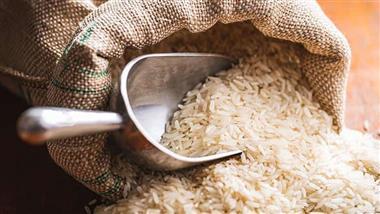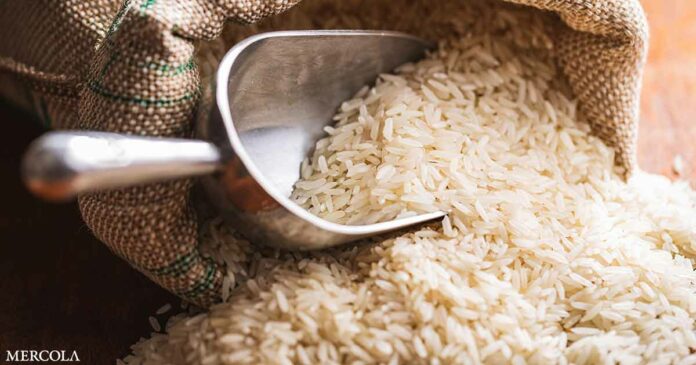
Story at-a-glance
- More than 1 in 4 rice products sold in the U.S. now exceed the FDA’s arsenic limit for infant cereal, exposing families to heavy metals that harm brain development, kidneys, and long-term health
- Brown rice grown in the southeastern U.S. was the most contaminated, while white basmati from India, Thai jasmine and California-grown white rice had the lowest heavy metal levels
- Cooking rice in extra water and draining it like pasta cuts arsenic exposure by up to 60%, making it one of the simplest ways to reduce your toxic load
- Children under 2 in Asian American and Latino households are exposed to two to four times more arsenic from rice than the general population due to higher rice consumption
- White rice is easier to digest and less inflammatory than brown rice for people with gut issues or mitochondrial dysfunction, making it a better choice for many; choosing lower-contaminated varieties and cooking them properly are key
More than 1 in 4 rice products sold in the U.S. now exceed the U.S. Food and Drug Administration’s (FDA) arsenic limit for infant cereal.1 This isn’t about obscure brands or specialty imports. It’s about the same white and brown rice that millions of families serve daily, unaware of the toxic load it’s delivering to their children.
Arsenic exposure during infancy and pregnancy poses an immediate threat to brain development, kidney function and lifelong health. For many families, especially Latino, Asian American, and Hispanic households where rice is a staple, the risks stack up fast. And it’s not just arsenic. Cadmium, a second heavy metal frequently found in rice, further burdens the kidneys and bones over time, compounding the damage.
This isn’t simply about what’s in your rice. It’s about what’s not being done to protect the people eating it. As you’ll see, recent investigations have made one thing clear: what kind of rice you buy, where it comes from and how you cook it dramatically change your exposure to toxic metals. Let’s look at what the researchers uncovered, and how their findings directly affect the choices you make at the grocery store.
Your Rice Choice Determines Your Toxic Load
In its comprehensive investigation titled “What’s in Your Family’s Rice?,” Healthy Babies Bright Futures (HBBF) tested 211 samples of rice and other grains sold in U.S. stores to determine levels of four toxic heavy metals: arsenic, cadmium, lead and mercury.2 The goal was to identify which rice types were most contaminated and whether common rice substitutes offered safer options. The findings reveal how specific grains, cooking methods and sourcing decisions directly influence your exposure.
• Heavy metal content varied dramatically by grain type — On average, rice contained three times more total heavy metals than the other grains tested. Arsenic was the most abundant contaminant in rice, averaging 84.8 parts per billion (ppb), while alternative grains averaged just 3.1 ppb — 28 times less. While cadmium levels were slightly higher in some substitutes, the overall toxic burden from non-rice grains was far lower.
• A few simple actions cut arsenic exposure by 69% — HBBF identified three strategies that, when used together, reduced heavy metal intake from rice significantly. These included cooking rice in extra water and draining it like pasta, choosing lower-contamination rice varieties and rotating in grain alternatives like barley, farro, or quinoa. This empowers you to take control without needing to eliminate rice completely.
• Cooking methods matter more than most people realize — Boiling rice in six to 10 parts water per one part rice, then draining it before serving, removed up to 60% of arsenic content. Soaking rice overnight beforehand further increased removal. This cooking method is both cost-free and highly effective, especially for families who cannot afford imported or specialty rice varieties. HBBF made it clear that rinsing rice alone is ineffective.
• Safer rice types aren’t always easy to afford — The report highlighted that California-grown white rice, Indian basmati, and Thai jasmine consistently tested lowest in heavy metal content. In contrast, Arborio rice from Italy and U.S.-grown white rice labeled simply as “USA” carried significantly higher contamination levels.
However, the lower-risk rice types are more expensive, averaging five times the cost per serving compared to standard rice. This puts lower-risk options out of reach for many families.
Some Precooked Rice Products Carry Hidden Dangers
Instant and parboiled rice had slightly lower total metal content, but HBBF warned that high-heat processing creates especially toxic forms of arsenic.3 Ready-to-heat food packaging also leaches harmful chemicals into the rice. For this reason, HBBF did not recommend these products as safer options despite the lower numbers on paper.
• Homemade doesn’t always mean healthy — Many parents make their own rice cereal assuming it’s safer than store-bought baby food. But HBBF found that rice used in homemade meals often exceeds the FDA’s infant safety limit for arsenic, meaning it would be considered unsafe if sold in stores. This is especially true when using brown rice or rice grown in southeastern U.S. regions.
• The FDA has set limits but only for one product category — Currently, the FDA has an action level of 100 ppb of inorganic arsenic for infant rice cereal. Yet this standard doesn’t apply to the rice served to the rest of the family, even though it’s consumed just as often by young children and pregnant individuals. Without regulation for regular rice, consumers have no guaranteed protection.
• Families need transparent labeling and enforceable safety standards — The HBBF report calls for three actions: enforceable federal limits for arsenic and cadmium in all rice, a certification label for rice that meets infant safety standards and mandatory testing with results shared publicly. These steps would not only help you make informed decisions — they would also push companies to improve their sourcing and processing methods.
Widespread Arsenic Contamination in Rice Shows No Signs of Slowing Down
HBBF analyzed 145 rice samples purchased across U.S. grocery stores and found arsenic in every single one. The most contaminated rice was brown rice grown in the southeastern U.S.
This type of rice had the highest combined load of heavy metals, reaching 151 ppb, with 129 ppb attributed to arsenic alone.4 For comparison, California-grown white sushi rice had the lowest levels tested — just 65 ppb total. The study found that contamination wasn’t linked to specific brands but instead to the type of rice and where it was grown.
• Children, infants and pregnant women face the greatest risk — According to HBBF’s analysis, rice is one of the top sources of arsenic exposure for children under 2, making up 7.5% of total intake in the general population. Arsenic and cadmium both cross the placenta, meaning exposure starts during pregnancy. These metals are linked to reduced IQ, neurodevelopmental damage and increased lifetime risk for cancers and kidney disease.
• Other toxic metals were found as well — Cadmium appeared in all but one of the 145 samples. Lead and mercury also showed up, though at lower levels. While these weren’t as high as the arsenic values, their presence in food consumed daily raises serious concerns for cumulative toxicity and long-term health effects.
Some Families Are Exposed to 2 to 4 Times More Arsenic Than Others
HBBF’s investigation uncovered not just widespread arsenic contamination in U.S. rice but a troubling pattern of disproportionate exposure across different communities.5 While contamination levels depended largely on the type and source of rice, the story focused on who is most affected. The analysis made it clear that infants and pregnant women from specific ethnic groups face significantly higher toxic exposures than others.
• Asian American, Latino and Hispanic infants carry the highest toxic load — Children under age 2 in these communities consume more rice per day than other groups, resulting in far greater arsenic intake. Rice accounts for up to 30% of arsenic exposure in Asian American infants — four times more than the general population.
• Pregnancy is a key window for harm — The brain is especially vulnerable during this period, and even low-level, chronic exposure to these metals has been associated with developmental delays, learning difficulties and lower IQ scores. According to the article, “early-life exposure to these contaminants is especially dangerous during pregnancy and infancy, when the brain is most vulnerable.”6
• Cadmium exposure is also widespread and just as dangerous — Cadmium was found in all but one of the 145 rice samples tested, and while it wasn’t always as concentrated as arsenic, the long-term effects are serious. The article linked cadmium to kidney and bone damage, and emphasized that it, too, is a known carcinogen. This makes the combined exposure from arsenic and cadmium even more hazardous over time.
• Labels often hide where rice is grown — Most rice products don’t clearly state where the rice was cultivated — yet this is the most important factor in determining risk. This means if you’re buying based on brand alone, you’re flying blind — and could be choosing one of the worst options without even knowing it.
How to Choose the Right Rice Without Giving It Up
You don’t have to cut out rice to protect your health, but you do need to be smart about which types you eat and how you prepare them. The idea that brown rice is always healthier doesn’t hold up if you’re dealing with mitochondrial stress or gut issues.
In fact, for many people, especially those struggling with inflammation or metabolic dysfunction, white rice is the better option. It’s easier to digest, far less likely to feed harmful gut bacteria and lower in both problematic fibers and omega-6 fats that disrupt cellular energy. Here’s how to keep rice in your diet while reducing your exposure to harmful contaminants and protecting your metabolic health:
1. Choose white rice over brown, and go for lower-risk varieties — White basmati rice from India, Thai jasmine rice and California-grown white rice are consistently lower in both arsenic and cadmium. Brown rice retains its outer layers, which are high in heavy metals and contains linoleic acid (LA). LA impairs mitochondria, makes inflammation worse and slows down your energy production. White rice strips these out and gives you a clean, starchy fuel without the added baggage.
2. Cook it like this to reduce the toxic load — Soak white rice for at least 30 minutes before cooking, then boil it in a large amount of water — 6 to 10 cups per 1 cup of rice — and drain it like pasta. This simple method removes up to 60% of the arsenic. Rinsing alone won’t cut it. The key is flushing the water, and the toxins, away before you eat it.
3. Avoid parboiled, instant and prepackaged rice products — These processed options are convenient, but they come with a tradeoff: more contamination and fewer nutrients. High-heat processing increases levels of inorganic arsenic, and plastic packaging often adds chemical residues. Stick with whole, unprocessed rice and cook it yourself to stay in control of what you’re putting on your plate.
4. Pair white rice with nutrient-dense sides — White rice doesn’t have to be the main event — what you serve with it makes all the difference. Combine it with protein, healthy fats, and vegetables to keep your blood sugar steady and your meals balanced. This is how rice has been used for centuries in traditional cultures.
5. For infants and toddlers, ditch brown rice-based baby food — If you’re feeding little ones, avoid rice cereal or porridge from brown rice, even if it’s homemade. Absolutely nothing compares to breast milk in terms of nutrition for infants, so if you are a new mother and still lactating, breastfeeding is the best choice for both you and your child. However, I understand that not all moms can breastfeed.
In this case, I recommend making your own infant formula using this recipe based on nutrient-rich animal foods like raw grass fed cow’s milk, organic raw cream, and grass fed beef gelatin. For children who are unable to tolerate milk proteins, I recommend trying this hypoallergenic meat-based formula instead.
Frequently Asked Questions About Arsenic in Rice
Q: What’s the biggest health concern with rice sold in the U.S.?
A: The primary concern is arsenic, a toxic heavy metal found in more than 1 in 4 rice products sold in U.S. stores at levels that exceed the FDA’s safety limit for infant rice cereal. Cadmium, lead and mercury were also detected, with arsenic being the most abundant and dangerous due to its strong links to cognitive impairment, cancer, and kidney damage.
Q: Is brown rice healthier than white rice?
A: Not necessarily. While brown rice retains more nutrients, it also holds higher concentrations of arsenic and polyunsaturated fats like LA, which worsen inflammation, mitochondrial function and insulin resistance. White rice is often safer and easier to digest, especially for individuals with gut issues or chronic disease.
Q: What kind of rice is safest to eat?
A: The lowest-contamination varieties are white basmati rice from India, Thai jasmine rice and California-grown white rice. These types consistently test lower in arsenic and cadmium than brown rice and rice grown in the southeastern U.S.
Q: Can I reduce arsenic by cooking rice differently?
A: Yes. Cooking rice in six to 10 parts water and draining it afterward removes up to 60% of the arsenic content. Soaking the rice beforehand boosts the effect. Rinsing alone is not effective, and instant or prepackaged rice carry hidden risks from processing and packaging.
Q: Are certain populations more at risk from contaminated rice?
A: Yes. Infants, pregnant women and families from Latino, Asian American, and Hispanic communities tend to eat more rice and are therefore more likely to be exposed to higher arsenic levels. Arsenic crosses the placenta and has been linked to reduced IQ and kidney damage, making early-life exposure especially harmful.
Test Your Knowledge with Today’s Quiz!
Take today’s quiz to see how much you’ve learned from yesterday’s Mercola.com article.
Why might the high linoleic acid content in seed oils affect your long-term well-being?
Source: Source link
Publish Date: 7/7/2025 12:00:00 AM

